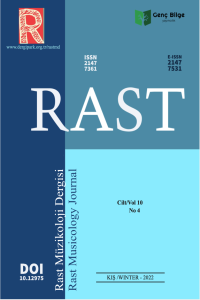Abstract
Keywords
neo-Riemannian theory transformational theory chromatic mediant relationship Hollywood film score film music
References
- Cohn, R. (1998). Introduction to Neo- Riemannian theory: a survey and a historical perspective. Journal of Music Theory, 42(2), 167-169.
- Cohn, R. (1998). Square dances with cubes. Journal of Music Theory, 42(2), 283-296.
- Cohn, R. (2012). Audacious euphony: chromatic harmony and the triad’s second nature. Oxford: Oxford University Press.
- Cook, N. (1992). A guide to musical analysis. New York: W. W. Norton & Company.
- Cooke, M. (2010). A history of film music. Cambridge: Cambridge University Press.
- Cornelius, S., & Mary N. (2018). Music: a social experience (2nd ed). New York: Routledge.
- Davis, R. (2010). Complete guide to film scoring (2nd ed). Boston: Berklee Press.
- Douthett, J., & Steinbach, P. (1998). Parsimonious graphs: a study in parsimony, contextual transformations, and modes of limited transposition. Journal of Music Theory, 42(2), 241-263.
- Fandom. (2022, June 15). https:// thehungergames.fandom.com/wiki/Horn_ of_Plenty.
- Fandom. (2022, July 17). https://inception. fandom.com/wiki/Dream_Is_Collapsing.
- Fandom. (2022, July 18). https://villainsong. fandom.com/wiki/Gollum%27s_Song.
- Genius. (2022, August 19). https://genius. com/Emiliana-torrini-gollums-song-lyrics.
- Gollin, E., & Rehding, A. (Eds.). (2014). The oxford handbook of Neo-Riemannian music theories. Oxford: Oxford University Press.
- Heine, E. (2021). Chromatic mediants through the context of film music. In Leigh V (Eds.), The Routledge companion to music theory pedagogy (pp. 152-156). New York: Routledge.
- Kalinak, K. (2010). Film music: a very short introduction. Oxford: Oxford University Press.
- Kopp, D. (2006). Chromatic transformations in nineteenth-century music. Cambridge: Cambridge University Press.
- Kostka, S., & Matthew S. (2018). Materials and techniques of post-tonal music (5th ed). New York: Routledge.
- Lehman, F. (2012). Reading tonality through film: transformational hermeneutics and the music of Hollywood. PhD Dissertation. Harvard University, Cambridge, US
- Lehman, F. (2013). Transformational analysis and the representation of genius in film music. Music Theory Spectrum, 35(1), 1-22.
- Lehman, F. (2015). Scoring The President: Myth and Politics in John Williams’s JFK and Nixon. Journal of the Society for American Music, 9(4), 409–444.
- Lehman, F. (2018). Hollywood harmony: musical wonder and the sound of cinema. Oxford: Oxford University Press.
- Lewin, D. (2009). Studies in music with text. Oxford: Oxford University Press.
- Lewin, D. (2010). Generalized musical intervals and transformations. Oxford: Oxford University Press.
- Lewin, D. (2010). Musical form and transformation: four analytic essays. Oxford: Oxford University Press.
- Murphy, S. (2013). Transformational theory and the analysis of film music. In David N (Eds.), The oxford handbook of film music studies (pp.471-496). Oxford: Oxford University Press.
- Ramirez, M. (2013). Chromatic-third relations in the music of Bruckner: a Neo- Riemannian perspective. Music Analysis, 32(2), 155-209.
- Rings, S. (2011). Tonality and transformation. Oxford: Oxford University Press.
Abstract
Keywords
neo-Riemannian theory transformational theory chromatic mediant relationship Hollywood film score film music
References
- Cohn, R. (1998). Introduction to Neo- Riemannian theory: a survey and a historical perspective. Journal of Music Theory, 42(2), 167-169.
- Cohn, R. (1998). Square dances with cubes. Journal of Music Theory, 42(2), 283-296.
- Cohn, R. (2012). Audacious euphony: chromatic harmony and the triad’s second nature. Oxford: Oxford University Press.
- Cook, N. (1992). A guide to musical analysis. New York: W. W. Norton & Company.
- Cooke, M. (2010). A history of film music. Cambridge: Cambridge University Press.
- Cornelius, S., & Mary N. (2018). Music: a social experience (2nd ed). New York: Routledge.
- Davis, R. (2010). Complete guide to film scoring (2nd ed). Boston: Berklee Press.
- Douthett, J., & Steinbach, P. (1998). Parsimonious graphs: a study in parsimony, contextual transformations, and modes of limited transposition. Journal of Music Theory, 42(2), 241-263.
- Fandom. (2022, June 15). https:// thehungergames.fandom.com/wiki/Horn_ of_Plenty.
- Fandom. (2022, July 17). https://inception. fandom.com/wiki/Dream_Is_Collapsing.
- Fandom. (2022, July 18). https://villainsong. fandom.com/wiki/Gollum%27s_Song.
- Genius. (2022, August 19). https://genius. com/Emiliana-torrini-gollums-song-lyrics.
- Gollin, E., & Rehding, A. (Eds.). (2014). The oxford handbook of Neo-Riemannian music theories. Oxford: Oxford University Press.
- Heine, E. (2021). Chromatic mediants through the context of film music. In Leigh V (Eds.), The Routledge companion to music theory pedagogy (pp. 152-156). New York: Routledge.
- Kalinak, K. (2010). Film music: a very short introduction. Oxford: Oxford University Press.
- Kopp, D. (2006). Chromatic transformations in nineteenth-century music. Cambridge: Cambridge University Press.
- Kostka, S., & Matthew S. (2018). Materials and techniques of post-tonal music (5th ed). New York: Routledge.
- Lehman, F. (2012). Reading tonality through film: transformational hermeneutics and the music of Hollywood. PhD Dissertation. Harvard University, Cambridge, US
- Lehman, F. (2013). Transformational analysis and the representation of genius in film music. Music Theory Spectrum, 35(1), 1-22.
- Lehman, F. (2015). Scoring The President: Myth and Politics in John Williams’s JFK and Nixon. Journal of the Society for American Music, 9(4), 409–444.
- Lehman, F. (2018). Hollywood harmony: musical wonder and the sound of cinema. Oxford: Oxford University Press.
- Lewin, D. (2009). Studies in music with text. Oxford: Oxford University Press.
- Lewin, D. (2010). Generalized musical intervals and transformations. Oxford: Oxford University Press.
- Lewin, D. (2010). Musical form and transformation: four analytic essays. Oxford: Oxford University Press.
- Murphy, S. (2013). Transformational theory and the analysis of film music. In David N (Eds.), The oxford handbook of film music studies (pp.471-496). Oxford: Oxford University Press.
- Ramirez, M. (2013). Chromatic-third relations in the music of Bruckner: a Neo- Riemannian perspective. Music Analysis, 32(2), 155-209.
- Rings, S. (2011). Tonality and transformation. Oxford: Oxford University Press.
Details
| Primary Language | English |
|---|---|
| Subjects | Music |
| Journal Section | Original research |
| Authors | |
| Publication Date | December 30, 2022 |
| Published in Issue | Year 2022 Volume: 10 Issue: 4 |
Our authors are required to respond to editorial emails within 3 days to avoid any disruption to the editorial process.

